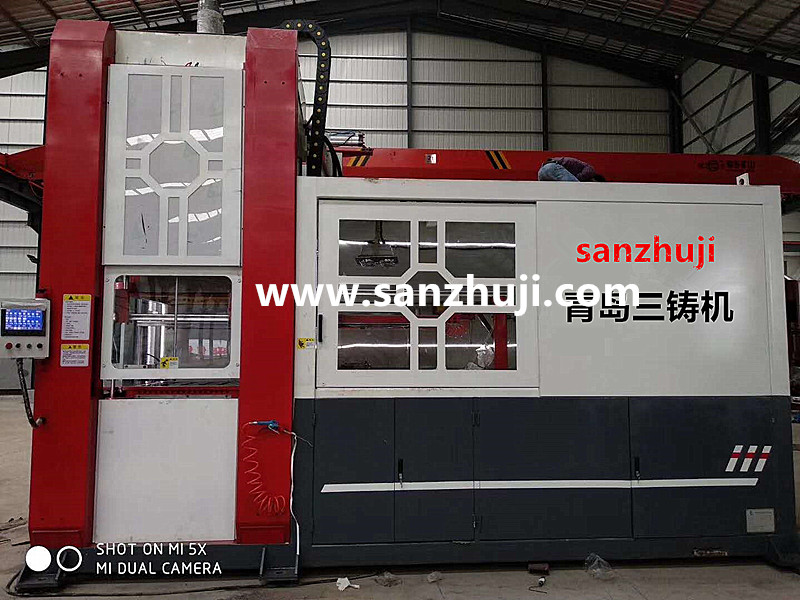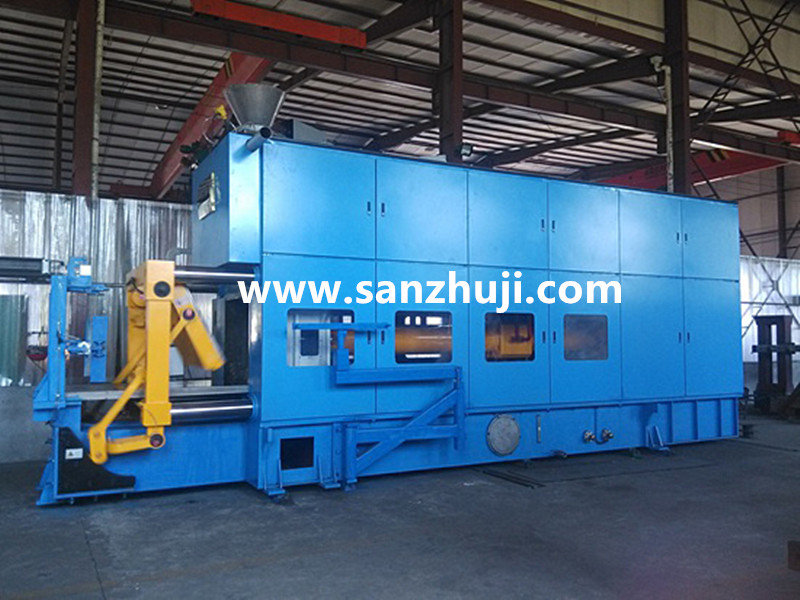1.bending cavity products sand cleaning difficulties
Bending cavity structure products reducer tee, for example, the product cavity is curved, and the diameter of the exit end is gradually reduced. Using silica-sol shell technology to produce a high strength shell. Because the inner cavity of the product is shaped smooth transition tube, the inner cavity of the shell is formed after the formation of tubular or solid refractory layer, after casting, the internal cavity heat dissipation conditions are very poor, the formation of overheating points, resulting in the shell is sintered into a glass-like bond in the inner cavity of the casting, the shell collapse poor. The stress generated during the cooling shrinkage of the casting is more unable to promote the formation of tubular or solid refractory coating layer rupture, which causes great difficulties for the later sand removal in the inner cavity of the product. In the removal of such products in the cavity of the sand, usually using alkali cooking (explosion), HF acid immersion, high-pressure water impact, shot blasting, manual chiseling and other methods.
Alkali boiling (explosion) and HF acid soaking is a method of chemical cleaning of the residual adhering sand on the casting, but can not completely remove the cavity of such products, resulting in the existence of "dead ends". In the shot blasting process, the high-speed movement of the steel shot to the cavity "dead", there is no impact effect, can not completely remove the sand.
By analyzing the structural characteristics of the product, to solve the problem of cleaning the cavity residual sand, can start from improving the shell making process, by improving the formation of the inner cavity of the tube or solid refractory coating layer of the collapse, can achieve the purpose of solving the problem.
2.Shell inner and outer strength analysis
In order to understand the difference in strength between the inner and outer layers of the shell formed by the bending structure, a circular wax mold with wall thickness of 5mm, length of 40mm, and inner diameters of 5mm, 8mm, 12mm, 16mm, and 20mm was prepared, and sand was hung according to the production process to produce sand layers of 1 to 6 layers, and the baked shells were used as specimens. Bending strength tester is used to test the shell strength of 5 groups of specimens at room temperature: load until the outer layer of the specimen is broken, and record the load value; remove the broken outer layer of the specimen, and then load the inner layer of the specimen until it is broken, and record the load value. The ratio of the load values of the broken inner and outer layers of the specimen is approximated as the ratio of the strength of the inner and outer layers of the specimen for analysis, and it is obvious that the inner and outer shell strengths of the specimen (hereinafter referred to as the inner and outer strengths) have obvious differences. It can be seen from the data that under normal sand hanging conditions, the shell strength is generally greater than the strength of the outer forming shell, increasing its collapsibility, but not to reduce the outer shell strength of the product, which means that the strength of the tubular shell formed in the inner cavity needs to be reduced relatively. According to this idea, the refractory material with the characteristics of collapsibility is chosen to manufacture the shell, thus reducing the strength of the inner cavity tubular shell.
3.Characteristics and selection of laminated sand
The laminated sand has the following characteristics:
3.1 High strength, low gassing and low expansion.
3.2 good collapsibility and high compactness.
3.3 non-lamination, good thermal stability, good thermal conductivity and good fluidity.
3.4 high temperature resistance, good anti-adhesive sand.
The main role of laminated sand additives is to improve the performance of the laminated sand, to use the collapse of the laminated sand to solve the problem of shell clear sand, the main thing is the need to choose the right laminated sand.
The selection of cladding sand need to consider the main issues into, and shell making process of coordination consistency, can achieve the purpose of easy collapse.
sanzhuji through and cladding sand manufacturers together on the cladding sand collapse analysis and research, many times compared, and finally determine the best range of easy to collapse cladding sand additives to add.
4.the two processes shell strength comparison
The shell making process of silica sol, the first layer (surface layer) shell direct contact with the metal liquid, determine the surface quality of the casting, generally for the wrong British powder and wrong British sand; the third and later layers (back layer) to enhance the strength of the shell, generally for the aluminum-silicon refractory materials; the second layer is a transition layer, play a role in linking the surface layer and back layer. So the first layer (surface layer) and the second layer should not be added to the film sand, and this type of cavity is generally hanging in the third layer, the fourth layer of paint, the cavity is basically blocked, so the best to add hanging film sand after the third layer. In the shell making process, only the 3rd and 4th layers are added to the clad sand, and the other layers are hung according to the normal sand hanging process. Instead of coating all parts of the shell with the sand, the sand is targeted only to the parts that form the inner cavity. The main purpose of this is to make the shell from the shell making process so that its internal and external "inconsistency", to destroy the integrity of the shell, to create conditions for the later sand collapse. Because the surface of the clad sand is attached to a layer of resin, the surface is clean, changing the shape of the original sand particles, making the shape of the particles to round, which will reduce the permeability of the shell, so when hanging clad sand should be separately configured coating, coating viscosity than the general backing layer coating 3-5s less.
The shell making process is especially important to control the drying of the inner cavity of the shell when adding the coating sand layer, because the drying effect will directly affect the normal and high temperature strength of the shell. The drying time when adding the coating sand layer is based on the principle of ensuring that the shell is fully dried, and the temperature and humidity in the drying room must be strictly controlled.
In order to verify the effect of adding the coating sand on the strength of the inner and outer layers of the shell, the same size and number of specimens were prepared again, only adding the coating sand in the third and fourth layers. Again, the ratio of the crushing load values of the inner and outer layers of the specimen was approximated as the ratio of the strength of the inner and outer layers of the specimen, and it can be seen that the ratio of the strength of the inner and outer layers has a relatively obvious change
The difference between the strength of the tubular shell layer formed in the inner cavity of the shell and the strength of the outer shell layer of the product is very obvious after the coating of the sand. The strength ratio of inner and outer shell layer is obviously decreased, which means that the collapse of tubular shell layer formed in the inner cavity of product shell is effectively improved. Through the actual production of 20 consecutive batches of dust collector body, reducer tee each 180 pieces of products show that the inner cavity of the product sand cleaning difficulty decreased, more than 45% of the products through the shock shell and shot blasting, the inner cavity without residual sand adhesion; about 50% of the products through the shot blasting of the inner cavity of the sticky sand is basically clean; the remaining products to extend the shot blasting time can also be completely clean inner cavity.
5.Conclusion
In the silica-sol investment casting process for products with curved cavity structure, the strength of the inner and outer shell layer can be improved by changing the refractory material for sand hanging and developing the corresponding process. The application of suitable performance requirements of the overlay sand can improve the collapse of the silica-sol investment casting process shell layer, for the cavity of complex precision casting parts to provide a solution to the problem of sand cleaning.
Qingdao Sanzhuji Equipment Manufacturing Co., Ltd. specializes in the production of sand reclamation equipment,foundry machines,Sand casting equipment,GS high efficiency rotary mixer,no-bake resin sand mixer,Jolt squeeze molding machine/Jolt-squeezing moulding machines,Multi- Piston Moulding Machine/Hydraulic multi-piston moulding machine,foundry molding machine,flaskless moulding machine,shot blasting machine,dust collector,according to the amount of old sand recovered Carry out plan customization, and provide sand reclamation equipment installation, commissioning, and training. Welcome guests to visit the factory.








